Change font size -A A +A ++A

The team of TMBU visits Garbadih.
Our Bureau/
Archaeologists from Tilka Manjhi Bhagalpur University (TMBU) and a group of historians have the substantial evidence that at the heart of Anga Pradesh an rural civilization was enriching dating back 1000 BC which claimed to be pioneer of the urban civilization of Champa, the erstwhile kingdom of Anga Pradesh.
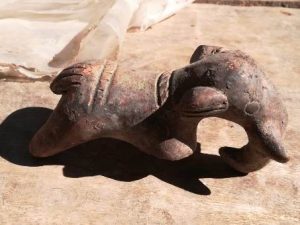
A Terracotta sculpture found at Garbadih.
The experts claimed that the forgotten civilization on the bank of river Kosi at a place named Gabradih falling under Bihpur block of Naugachia sub-division of Bhagalpur transformed the urban civilization of Champa. Villagers recently recovered broken utensils and other items related to daily life, allured the team from TMBU to conduct inquiry on the recovered items.
“Located beside turbulent river Kosi the mount of Gabradih has been always remained mystery for many. The items were recovered recently from the place. But unfortunately, massive erosion caused by Kosi for last several year has almost engulfed over sixty percent of the total areas which we suspect the original place of the rural civilization,” pointed out Beheri Lal Choudhuary, head of post graduate department of ancient Indian history culture and archaeology. He further added that Gabradih is unique in its kind. “ Till now such early civilizations could be found in the banks of rivers like Saraswati (now disappeared), Ganga etc. But such evolution of urban culture of early period at the bank of river Kosi is really an instant,” he added further.
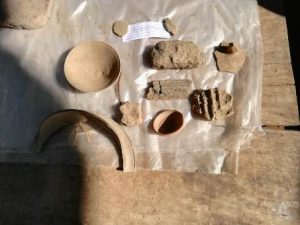
Some broken utensils found at Garbadih.
According to him after conducting the study, it was found that the materials are from dated back 1000 BC’s BRW culture (black and red ware culture) to second urbanization’s NPBW culture ( the northern black polished ware culture). “ The other findings like Terracotta sculptures, broken utensils, broken substances made of copper, other broken utensils and bricks (16.1X2X 2101X11/2 Inch) are mostly from Kushan period of 1 st century BC to 12 th century,” Choudhary explained.
Raman Sinha, a senior faculty of department of history at TMBU who also accompanied the team put emphasis on the periods of the objects recovered which indicates that the civilization at the areas of Gabradih was much older than that of the urban civilization of Champa. “Gabradih must have influenced Champa to flourish which continued till 12 th century BC,” Sinha marked.
Former deputy director at PRD, Bihar government and historian, Shiv Shanker Singh Parijat said that that Champa might have immerged as most decorative Mahanagar during 6 th century BC but it was extemporarily transformed into a Mahajanpad among the 16 Mahajanpad of northern India till 12 th century BC, and it was a gradually evolved. “But we have no point to say that Gabradih was the pioneer of the civilization of Champa,” Singh who also visited the place with the TMBU’s team confirmed.
The team members claimed that the findings of materials of BRW culture period at Gabradih clearly indicates towards the early stage of urban settlement. And the rise of Champa was done on the background of systematic yield of agricultural products from 6th century BC soon after the invention of iron made equipment. “Extensive research should be done immediately to know more facts about the place Gabradih which should be accompanied by excavation of the entire areas,” Choudhary pointed out.
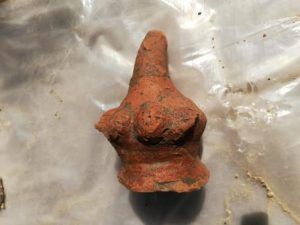
Ancient remains found at Garbadih.
Pawan Shekhar and Dinesh Kumar, faculty members of post graduate department of ancient history of TMBU and Rinki Kumari, a student of post graduate department of tourism, TMBU who were accompanying the team, expressed their utter concerned on the rapid erosion caused by river Kosi at Gabradih. “I was thrilled to witness the existing mount which now at some 25 feet high. It was really the treasure trove of history but it’s under the threat of Kosi,” Rinki pointed out.
“There was a unique old temple with an ancient deity at Gabradih which lost forever into the river bed earlier. Appropriate measures should be taken immediately just to save the testimony of ancient time,” Pawan Shekhar and Dinesh Kumar pointed out.

TMBU’s team has strenghten the need of extensive works at Gabradih.
“Anga always have its importance in term of enrich culture and traditions, education and academic skills and above all due to the ancient settlement of urban civilization. But Magadh immerged as most powerful region mainly due to Buddha who maximum spent his time at Magadh and secondly due to political events. Unfortunately, nothing has done so far at Anga Pradesh, mainly at Champa for the sake of the learners of history and archaeology,” Singh said.
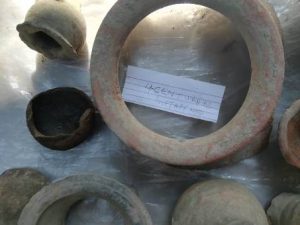
Garbadih’s findings: milestone to history.
“Place like Vikramshila has been ignored. So with Champa, the state government has no intension to do good marketing in terms of tourism which has become a prosperous income generating source of governments in other countries. The land has historical and archaeological significances and the government would have to do just one thing, ie conservation and developing infrastructures at such places at Anga Pradesh, there will be a boom in tourism,” Singh pointed out.
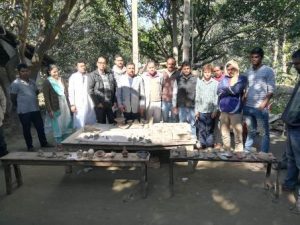
TMBU’s team collecting evidences.
“Garbadih findings are very important and there should be proper measures to protect such rare instances of history. We will try for the best with our limited resources but hope for government’s patronage properly to project not only Garbadih but entire Anga Pradesh on the world’s tourism map,” Choudhary pointed out.



Leave a Reply